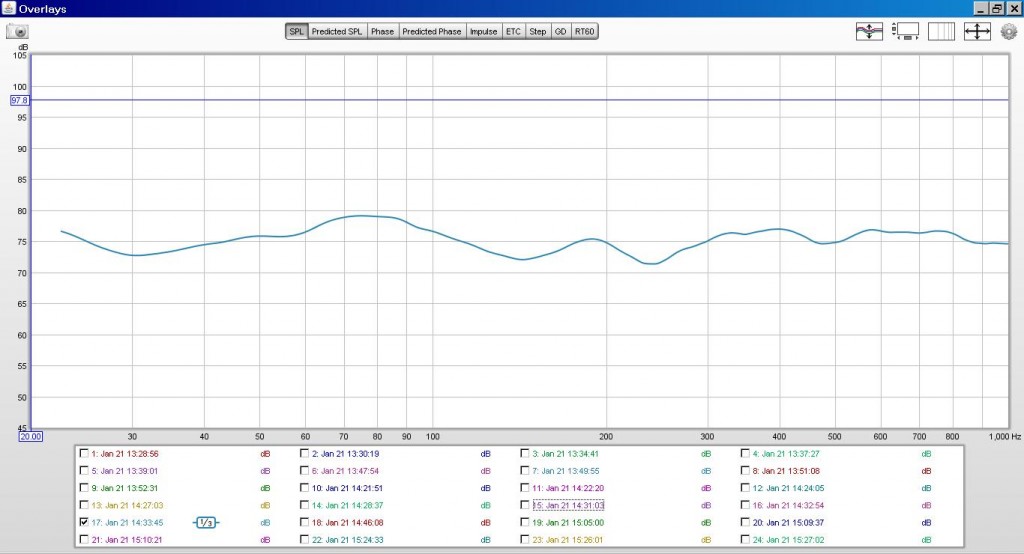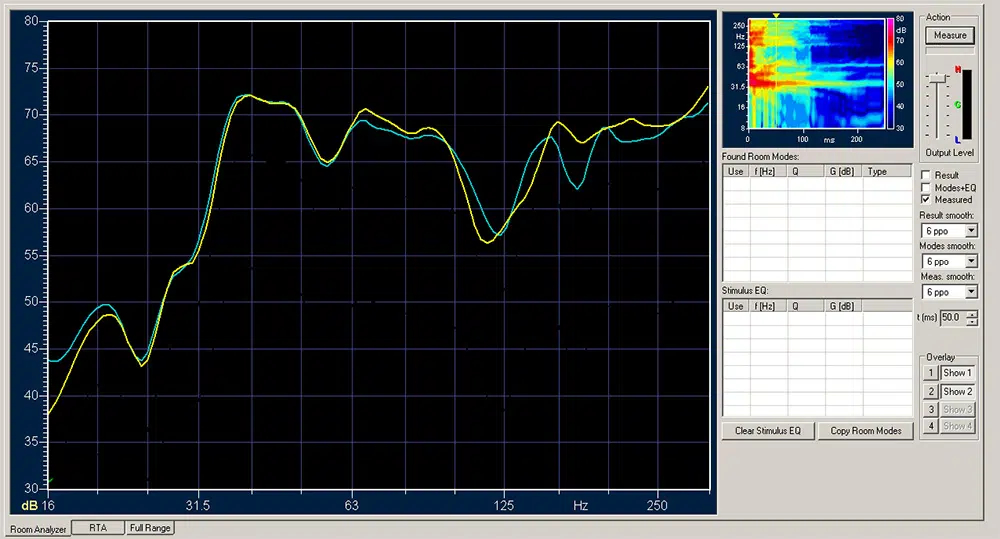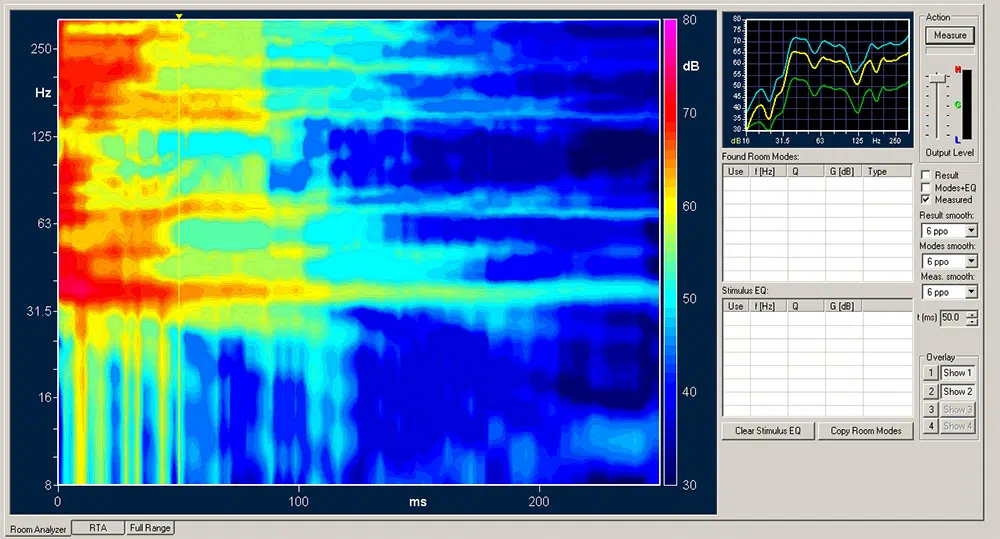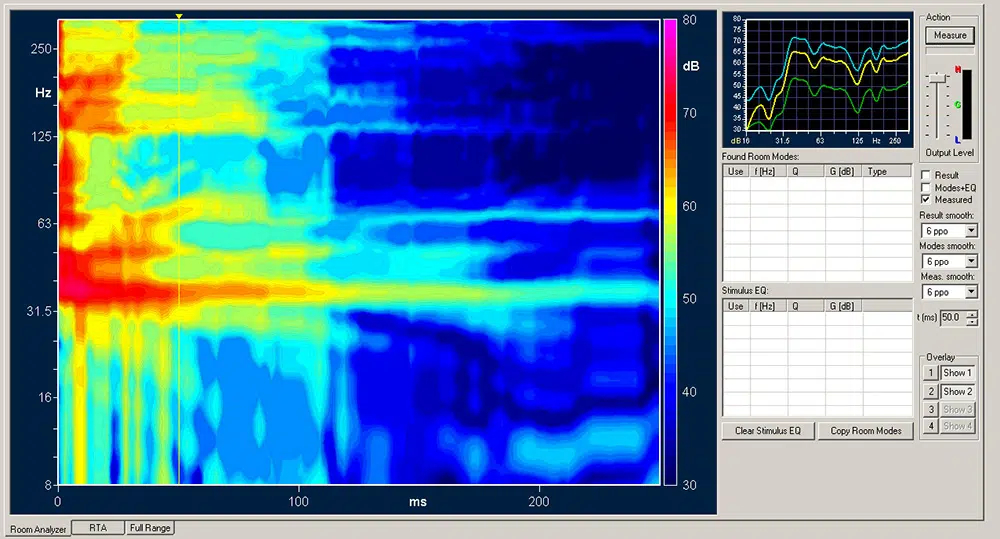Now that we’re moved into our new space in Downtown Bellevue our system is set up and we’ve got a lot of work ahead to try to perfect our sound. Room Acoustics account for 1/3 of your sound and as I mentioned in my initial article about this new location, it suffers from extreme echo, due to the 20ft ceilings in the listening space. I later found out that we also have some bass issues, which we’ll discuss below.
The image below is what we’re shooting for with our room. This is a frequency response measurement from Bruce Brown’s room at Puget Sound Studios. It shows the volume levels of a recorded test sweep, from the low bass to the upper treble. Ideally, each frequency in a system should play at the same decibel volume (dB). In this room, we see the highest volume level at around 80Hz at 79dB and the lowest level around 240Hz at 72dB. That’s no more than a 7dB differential anywhere throughout the full spectrum. No doubt Bruce will find a way to improve on this, but don’t get the idea that this kind of performance is easy to achieve or even possible for the majority of us. These measurements were taken in a custom-designed studio environment. If you don’t have an ideal room to tear down to the studs and rebuild, about $50-100k and a few years to perfect it, you won’t be able to achieve these kinds of results.

We used the XTZ Room Analyzer, which is a computer hardware (USB microphone) and software package (see the note at the bottom for more info). Below is our starting room measurement with just the bass (up to 300Hz). The yellow line is the room with bare walls and the blue line is with some generic bass traps we’ve been using until we take on the line of RPG treatments later this summer. We haven’t added a subwoofer to this room yet either, so the bass goes down to 35Hz with our Zu Druid Mk5 speakers. Our loudest level is 72dB at 35Hz and our lowest is 57dB at 125Hz; if it weren’t for the big dip at 125Hz we’d be doing pretty good with a differential of about 10dB. The bass traps don’t make a major difference in the levels, but they yield some improvement from 60-80Hz, which is probably correlated to the improvement at 125Hz. The next set of images shows where we can really hear the difference with the current traps.

These images show the timing of the tone at each frequency as it goes up the spectrum. This measurement mode is another feature of the XTZ Analyzer. Red is not what we want; it indicates that the bass is lingering too long at that frequency, which causes interference.
Here we see how the same measurement looks with the traps back in place. There’s a lot of improvement with the red dissipating in the range above 63Hz (these particular traps aren’t rated to be effective below 63Hz), particularly at 63Hz and the range between 125-250Hz.
Below is yet another measurement mode with the XTZ software, showing the before and after results of a full spectrum measurement (low bass to upper treble). The treble is unchanged in both measurements, which is expected because these traps aren’t made to correct that range.
We see three big dips between 4-8kHz. My best guess is that these are caused by our room echo and will hopefully be corrected with some RPG diffuser treatments. However, looking at the 3-D waterfall charts there is less of a rise in the peaks, particularly in the middle to right portions (it may be hard to tell unless you can flashback and forth between the two images); this tells us that our response times are closer to where they should be.
For now, there’s not much more to do. Later this summer we’ll start retailing RPG room treatments in our online store and install a range of these products. RPG has some of the most effective room treatments on the market (these products are used in places like Carnegie Hall) and they have a tuned bass trap that works in the 30-50Hz range, which will be perfect for that little hump we have at 40Hz. RPG diffusion products will clean up the echo and even out the treble. We’ll also add a Zu Audio Undertone subwoofer to the room, so we can get down as low as 15Hz.
Note: call or email us if you’re interested in the XTZ Room Analyzer tool for your system. You can read more about it in the 6Moons review below. This is a very powerful and easy to use tool, but bear in mind that if you don’t have a subwoofer (which will have EQ controls) or a range of room treatments there isn’t much you can do to correct these anomalies, you just will know where they are. Speaker placement or moving your listening seat are a few options, but those can also be done by ear and using your intuition; that’s how I’d recommend you handle those tasks.
https://www.6moons.com/audioreviews/xtz/xtz.html




